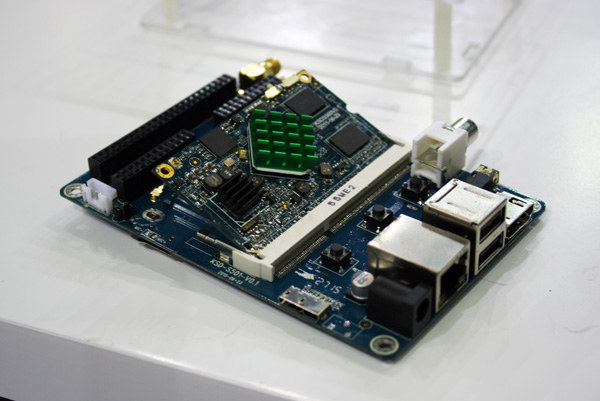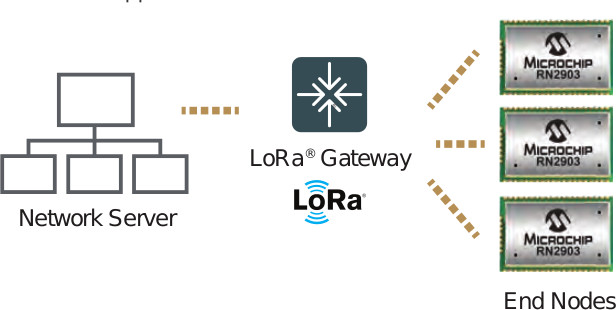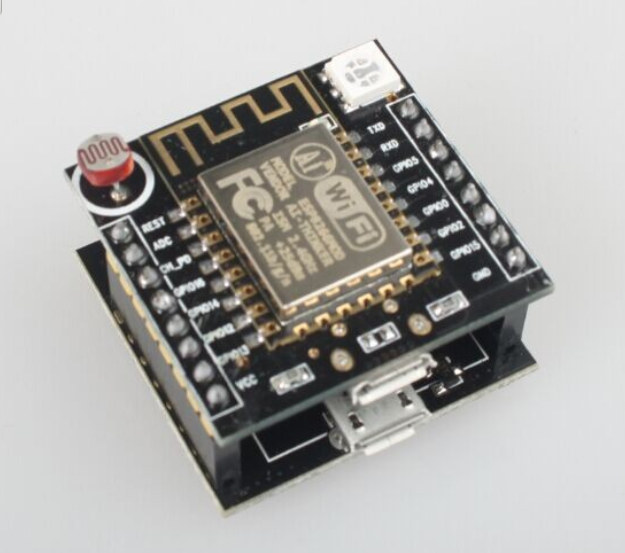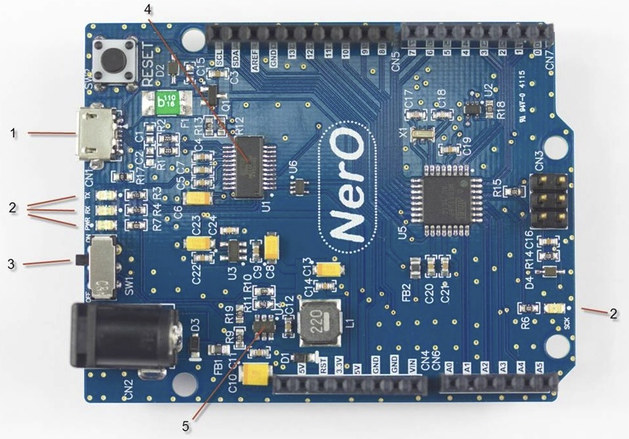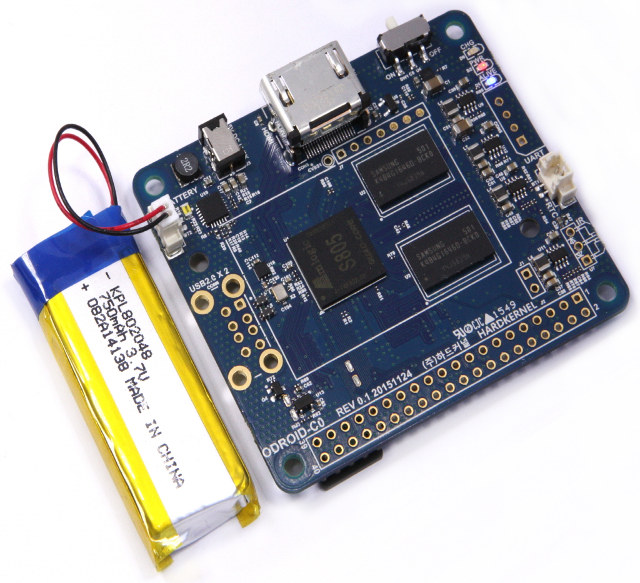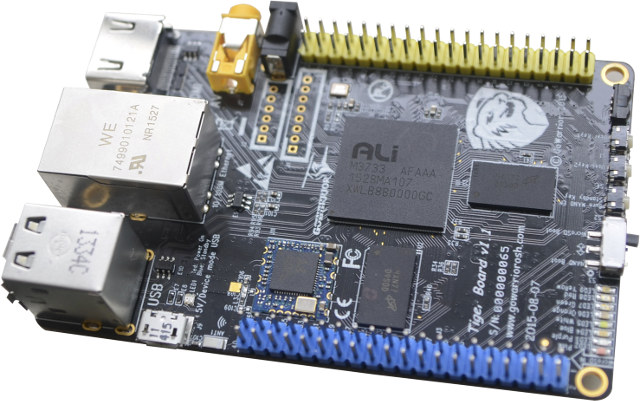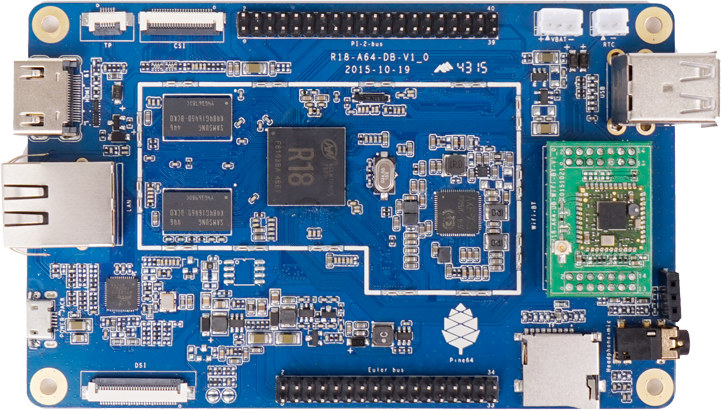I often read people complain about the lack of SATA and Gigabit Ethernet on devices, and following up a discussion on a recent post about QNAP TAS-168 and TAS-268 NAS, I was made aware that pcDuino3 Nano board had a little brother without NAND Flash, nor an IR receiver that’s currently selling for $15 on Amazon US. pcDuino3 Nano Lite board specifications are exactly the same as the other version minus the stricken-through items: SoC – AllWinner A20 dual core ARM Cortex A7 @ 1.0 GHz with Mali 400MP2 GPU System Memory – 1GB DRAM Storage – 4GB NAND Flash, SATA connector and microSD card slot (up to 32GB) Video Output – HDMI 1.4 with HDCP support Audio Out – 3.5mm analog audio interface Connectivity – Gigabit Ethernet USB – 2x USB host, 1x USB OTG Expansion Headers – Arduino UNO extension interface with 14xGPIO, 2xPWM, 6xADC, 1xUART, 1xSPI, 1xI2C. […]
Aceberry S500 is a $60 Actions Semi S500 Development Board Comprised of a Module and a Baseboard
For some hard-to-explain reasons, Actions Semi S500 processor seems to be a popular choice for makers of boards, although I don’t think it has really been a success with hobbyists and makers so far. After ActDuino S500, LeMaker Guitar, Lemon Pi, Allo SPARKY, and Roseapple Pi boards, here comes another S500 quad core Cortex A9 development board with Aceberry S500 that’s quite inspired by LeMaker Guitar as seen by its baseboard and module design. Aceberry S500 board preliminary specifications: SoC – Actions Semi S500 quad core Cortex A9r4 processor @ 1.6GHz with PowerVR SGX544 GPU @ 500 MHz Memory – 1 GB DDR3 Storage – 8GB eMMC or NAND flash (16 and 32GB optional), SPI NOR flash Video Output – HDMI, and LCD connector Audio – HDMI, headset jack, digital output (RCA). Video Codec – H.265 (HEVC) and Ultra HD (4K*2K) video playback. Encoding up to 1080p@60fps. Connectivity – 10/100M […]
Microchip Introduces $11 RN2483 & RN2903 LoRa Modules and $70 LoRa Evaluation Kits for IoT & M2M Applications
LoRa is one of those long range low power WAN standards used for the machine to machine (M2M) and Internet of things (IoT) applications. I already featured a Semtech Lora module here with a line-of-sight range of up to 20 to 30km, and the company has just partnered with STMicro to deploy LoRa solutions, but today, I’m going to have a look at Microchip Lora modules and development kits that I discovered in the company’s Micro Solutions Nov/Dec 2015 publication. The company has launched two modules for the European and North American markets with respectively RN2483 LoRa 433/868 MHz R&TTE Directive Assessed Radio Modem and RN2903 915 MHz North American modem. Apart from the different frequencies, both modules have similar features: On-board LoRaWAN Class A protocol stack Tx/Rx Power RN2483 – 40 mA (14dBm, 868MHz) Tx, and 14.2 mA Rx @ 3.6V RN2903 – 124 mA Tx max, and 13.5 mA […]
$3 Compact ESP8266 Board Includes RGD LED, Photo Resistor, Buttons and a USB to TTL Interface
In case you need a cheap and compact ESP8266 board with integrated USB to TTL debug interface, a photo resistor, and/or some buttons, a white brand board based on ESP-12F could be interesting. “Witty cloud” development board specifications: ESP-12F module with Espressif ESP8266EX SoC Connectivity – WiFi 802.11 b/g/n 2x 8-pin headers with GPIOs, VCC, GND, Reset, ADC, and UART USB – 2x micro USB port (one for power, one for debugging ?) Misc – Photo resistor, RGB LED, three buttons for power, reset and firmware upgrade (I think) Dimensions – Small Witty cloud might not be the same of the board itself, but could be a cloud service launched in China, as some of the screenshot on Aliexpress could imply. All I could find are some websites vaguely mentioning GoKit 3.0 and Witty Cloud 3.0, but it does not make much sense. If Chinese readers could provide some insights […]
FTDI NerO is an Energy Efficient Arduino UNO Compatible Board That Can Handle Higher Loads (Crowdfunding)
FTDI found out that the original Arduino UNO R3 boards had issues handling higher loads with 9V and 12V power input being limited to about 800mA and 300mA respectively before the voltage of the 5V regulator drops, so they decided to make their own supporting up to 1A. NerO board specifications: MCU – Atmel ATMega328 MCU @ 16MHz with Optiboot bootloader I/Os 14 Digital I/O Pins including 6 PWM outputs 6 Analog Inputs USB – micro USB port for programming using FTDI FT231XS USB UART interface (4) Misc – Status and PWR LEDs, on/off switch Power Supply – 7V to 20V ( 9V or 12V recommended ) via power barrel or VIN pin. 5V switching regulator. Dimensions – UNO R3 form factor FCC/CE certified The board is manufactured in Europe by MikroElektronika, a company which I started the hear about more and more, especially since they’ve launched their mikroBUS standard […]
ODROID-C0 Board is an Upcoming Alternative to Raspberry Pi Zero
When Raspberry Pi Zero launched at the end of November, it looked somewhat familiar to Hardkernel ODROID-W board that eventually had to be phased out as Broadcom would not sell Broadcom BCM2835 to the Korean company. In an interesting turn of events, Hardkernel has now shown the first prototype of ODROID-C0 (ODROID-C Zero), a tiny board based on Amlogic S805 found in ODROID-C1+. The name of the board may seem to be derived from Raspberry Pi Zero, but it’s not quite the case as Hardkernel first revealed their plans for ODROID-C0 back in November, a week before R-Pi Zero board was unveiled. ODROID-C0 will have similar specifications to ODROID-C1+ minus Ethernet, and the USB ports in order to reduce the PCB size: SoC – Amlogic S805 quad core Cortex-A5 processor with a Mali-450MP2 GPU System Memory – 1GB DDR3 Storage – eMMC module socket, and micro SD slot Video & […]
GoWarrior Tiger Development Board with ALi M3733 SoC To Support Android, Debian and FreeRTOS
There was a time when development boards were really hard to get for individuals with companies not wanting to waste their time with hobbyists, but the maker revolution changed all that, and now many companies want to get involved in “open source” board for the developer’s community. The latest board trying to emulate the Raspberry Pi is GoWarrior Tiger powered by ALi M3733 dual core cortex A9 processor with 1GB RAM, 4GB Flash, Ethernet and WiFi, HDMI and AV output, and two 40-pin expansion headers. Tiger board specifications: SoC – ALi M3733-AFAAA dual Cortex A9 processor @ 1.0 GHz with ARM Mali-400 MP2 GPU System Memory – 1GB DDR3; dual channel 1600 MT/s, 800MHz Storage – 4GB on-board NAND Flash + micro SD slot Video & Audio Output – HDMI 1.4 port up to 1080p, with support for HDCP and CEC, 3.5 mm AV jack Connectivity – 10/100M Ethernet, 802.11 […]
PINE A64 Development Board Kickstarter Campaign is Up
As previously announced, PINE64 $15 64-bit ARM Linux computer was due to launch on December 9, and the Kickstarter campaign is now up, and the shipping costs are $7 to the US, and $12 to the rest of the world. The name have changed to PINE A64 and PINE A64+ since the first announcement, but the specifications have mostly not changed for th two boards with an Allwinner quad core Cortex A53 processor, 512MB to 1GB RAM, a micro SD slot for storage, Gigabit Ethernet, HDMI 1.4, USB ports, and some other expansion headers for I/Os, displays or cameras. The PINE A64+ however now has an option for 2GB for $29, and we’ve got a bit more information about optional modules and accessories: Wireless module with WiFi and Bluetooth adapter Zwave adapter 7″ LCD touchpanel (PINE64+ only) Dry contact I/O board 5MP MIPI CSI camera Various sensors Various remote controls […]



